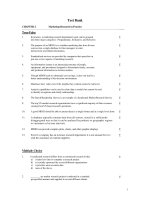Lecture Marketing research (12th edition) - Chapter 15: Sample size and statistical theory
Bạn đang xem bản rút gọn của tài liệu. Xem và tải ngay bản đầy đủ của tài liệu tại đây (734.68 KB, 21 trang )
1
Marketing Research
Aaker, Kumar,
Leone and Day
Twelfth Edition
Instructor’s
2
Chapter Fifteen
Sample Size and Statistical
Theory
Marketing Research 12th Edition
3
Determining the Sample Size
Ad Hoc Methods
•
•
Used when a person knows from experience what sample size to adopt
Used when budgetary constraints dictate the size of the sample
Rule of Thumb
•
•
•
Sample should be large enough, so that when divided into groups, each group will have a
minimum sample size of 100 or more
If analysis involves comparison between subgroups, sample size in each subgroup should
be 20 to 50
Use disproportionate sampling if one of groups of population is relatively small
Budget Constraints
•
Researcher must decide whether sample size dictated by budget constraints allows a
worthwhile study to be conducted
Comparative Studies
•
Find similar studies and use their sample sizes as a guide
Marketing Research 12th Edition
4
Factors Determining Sample Size
•
•
•
•
•
Number of groups and subgroups within the
sample
Value of information in the study
Accuracy level required in results
Cost of sample
Variability of the population
Marketing Research 12th Edition
5
Population
Characteristics/Parameters
Population Mean
•
•
Normally unknown
Determine value as closely as possible by taking a sample from
population
Population Variance
•
•
•
Measure of population dispersion
Based on degree to which a response differs from population
average response
The difference of each value from its mean is squared and averaged
across all responses
Marketing Research 12th Edition
6
Population
Characteristics/Parameters
The population opinion on symphony starting time (7:30 P.M. on weekdays)
Marketing Research 12th Edition
7
Sample Characteristics/Statistics
•
X
Sample mean ( ) is used to estimate the unknown population mean
Example: A sample of symphony seasonticket holders
Marketing Research 12th Edition
8
Sample Characteristics/Statistics (Contd.)
Sample mean
Marketing Research 12th Edition
9
Sample Reliability
•
•
X will vary from sample to sample
As sample size (n) increases, variation in X will decrease
standard error of decreases as the sample size gets
larger
Marketing Research 12th Edition
10
Sampling Distribution
Indicates probability of getting a particular sample mean
The normal distribution of X
Marketing Research 12th Edition
11
Sampling Distribution (Contd.)
X
The effect of increasing sample size on the normal distribution of
Marketing Research 12th Edition
12
Interval Estimation
•
•
•
•
X
varies from sample to sample
The difference between the sample mean ( ) and the
X
population mean is the sampling error X
Interval size depends on the confidence level the
researcher wants for the interval to contain the true
population mean
If the population standard deviation is not known, it is
necessary to estimate it with the sample standard
deviation
Marketing Research 12th Edition
13
Interval Estimation (Contd.)
Size of Interval Estimate depends on:
•
•
•
Confidence level
Population standard deviation
Sample size
Marketing Research 12th Edition
14
Sample Size Question
•
•
•
Size of the sampling error that is desired
Confidence level
Expected variance
Marketing Research 12th Edition
15
Determining the Population Standard Deviation
Options:
•
•
Use a sample standard deviation obtained from a
previous comparable survey or from a pilot
survey
Estimate the sample standard deviation (s)
subjectively
Marketing Research 12th Edition
16
Proportions
Population variance,
Marketing Research 12th Edition
17
Sample Size Formulas
Marketing Research 12th Edition
18
Coefficient of Variation
•
Researcher may require the sample estimate
be within plus or minus G percentage points of
the population value
Therefore,
D = Gµ
•
The sample size formula may be written as:
Marketing Research 12th Edition
19
Stratified Sampling
•
•
Useful when:
▫
The population standard deviation differs by strata
▫
The interview cost differs by strata
Optimal allocation of sampling budget to various strata:
Neyman’s solution
where
Marketing Research 12th Edition
20
Allocating Sample Size to Strata
where
Marketing Research 12th Edition
21
End of Chapter Fifteen
Marketing Research 12th Edition









